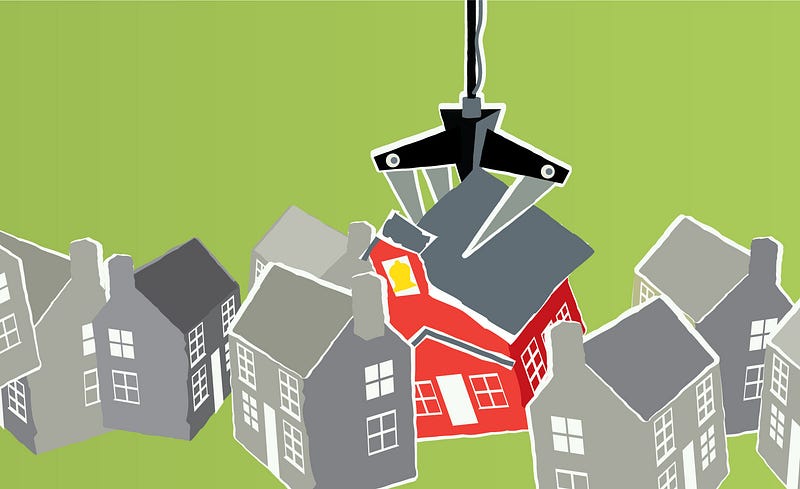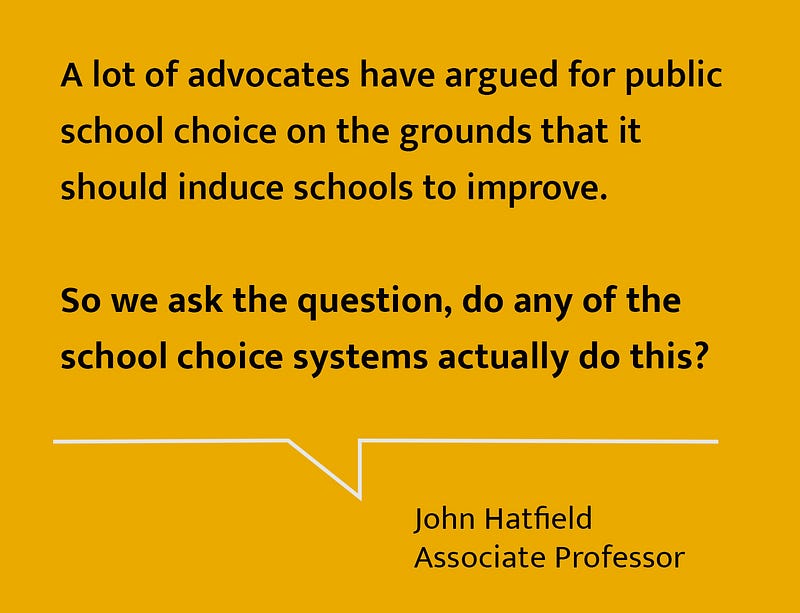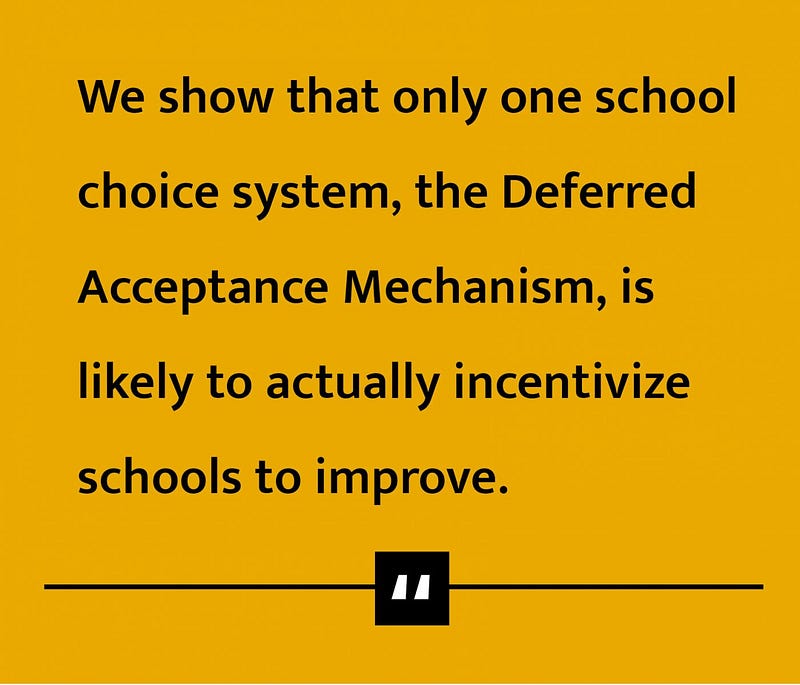Q&A: Does Public School Choice Make Schools Better?
Cities from Dallas to Boston to San Francisco use public school choice methods for matching kids to campuses, but policy debates ignite over whether or not they motivate schools to improve.
By Adrienne Dawson

Recently, there’s been a lot of talk (often heated) about school choice. But in many cities throughout the U.S., public school choice is already an established way of assigning kids, pre-K through high school, to campuses around the district. One of the biggest drivers surrounding the adoption of public school choice policies is the idea that doing so will motivate schools to make positive changes, leading to a better standard of education for all students. Until now, however, no one has studied whether school choice programs will actually improve school quality. McCombs Associate Professor John Hatfield explains how public school choice works and if any method leads to improvement.
School choice is a topic that’s been in the news lately, and you’ve been looking at a specific piece of that, which is public school choice. What is that, exactly?
Public school choice means that children aren’t zoned to schools based on where they live. Instead, parents throughout the entire district rank the schools they’d like their children to attend and submit those rankings to the school district. The school district then uses those rankings to determine which school each child attends.
There are many, many school districts that have been moving to this system because it gives parents more choice over where they can send their kids. Maybe I really want to send my daughter to this great theater school, or maybe I want to send her to a great science school.
But once you have this ability to choose, a natural question arises: Given each parent’s ranking, what procedure do you use to match students to schools? Maybe there’s a high school everybody wants to go to. Well, not everyone can.

What happens then?
When you solicit rankings, one of the big issues becomes whether or not it’s in the best interest of parents to tell the truth about their preferences over schools.
They could try to trick the system?
That’s exactly the right term for it. People start thinking strategically about how to rank their school preferences.
Maybe parents have heard they’re more likely to get their second choice, so they don’t list their preferences honestly?
Exactly. In fact, that’s what used to happen in Boston. Their old choice system had just that property. It turned out that you didn’t necessarily want to put your favorite school first. Instead, you wanted to put your favorite school that you had a reasonable chance of getting into first. So two parents, each with the same real preferences, might submit different preferences to the school district since one parent knew how to “game” the system and the other did not. That can lead to inequality in school access because it benefits parents who have figured out how to play the system.
A sophisticated parent might thus get a better placement for her child simply because she knew how to strategize. At the same time, a less sophisticated parent might not know anyone who can explain the system or the best way to strategize. They’re more likely to list their choices sincerely, but in some systems, that sincerity works against them.

How do you correct this?
You can design procedures that have the property that it’s always in a parent’s best interest to tell the truth. In the system that Boston currently uses, known as the Deferred Acceptance Mechanism, you should always tell the truth. It’s the optimal strategy, full stop. You can never do better by trying to game the system.
What’s the reasoning behind offering choice?
When you listen to discussions about why we might even have school choice systems to begin with, there’s a lot of talk about how it’s going to incentivize schools to improve. In market economies, that makes a lot of sense. Think about it like buying a dishwasher. If Consumer Reports says a certain dishwasher does the best job of washing dishes, maybe you’re willing to pay an extra $50 to buy it.
Now imagine that we’re talking about education. Parents would be willing to pay a lot more than $50 to get a better education for their kids, but you can’t choose to pay more to go a different public school in your school district. Of course some families might choose to go to private or parochial schools, but that’s an option we think many parents just don’t have financial access to.
So, we think that markets do a good job of incentivizing a dishwasher producer to build high-quality dishwashers, because then that producer can charge a higher price. But because you cannot pay to go to a different public school, this market logic doesn’t necessarily translate to the public school setting, even though the metaphor is compelling.
Which brings us to your research. In it, you’re doing something no one’s done before, which is to consider whether any of the school choice procedures used could actually incentivize schools to improve. What did you find?
We show that only one school choice system, the Deferred Acceptance Mechanism that some cities like Boston are now using, is likely to actually incentivize schools to improve.
How does it work?
It’s about matching up a student’s sincere preferences with a school’s priorities. For example, in New York City, schools have preferences for certain types of students. One school might prefer to enroll students who come to school every day but who maybe don’t have the best test scores — they think as long as they get the kid in school every day, they’ll be able to get them to learn. Another school might say no, we really want students with high test scores. We think if we can challenge them, they’ll want to stay in school. And some schools may give priority to students who live within walking distance of campus.
They have their own rubric.
Exactly. So what happens in Deferred Acceptance is that everyone applies, and everyone should list their favorite school as their top preferred choice. Then each school gets a list of all the students who picked them first, and from that list, they select the students who best meet their own priorities. Some students will get rejected because they either don’t match the school’s priorities or because they applied to a very popular school that had more applicants than seats. Those students are then considered for their second favorite choices.
Now maybe you have a case where a student picks School B as his second favorite school, and he’s actually School B’s preferred student type, but the school is already full after the first round. School B might accept that student in the second round and now reject a student they’d already taken from the first round who didn’t match their priorities as well as this new candidate. That student is then considered for their next choice, and so on and so on, until all students in the district are assigned to a school.
So it is in your best interest to tell the truth because it gives you the best chance of getting what you want?
Correct.

So how does this procedure get schools to improve?
A lot of advocates have argued for public school choice on the grounds that it should induce schools to improve. So we ask the question, do any of the school choice systems actually do this?
We find that no system does it perfectly, but in large districts Deferred Acceptance gets pretty close. Within our model, we should expect schools to choose to improve if they want to get better students. And in this case, “better” means students who more closely align with that school’s set of priorities, or their rubric, because if they improve, the students the school wants are more likely to select that school as their top choice.
And that doesn’t work if parents feel they have to manipulate the system, and the district is left guessing what people really want.
That’s right.
Do all districts in the U.S. that offer public school choice use this method?
No, they don’t, and sometimes it’s hard to know exactly what a city uses. But if districts that use public school choice want a model that leads to school improvement, we find that Deferred Acceptance is the best option.
Improving Schools Through School Choice: A Market Design Approach appears is the Journal of Economic Theory and is co-authored with Fuhito Kojima from Harvard University and Yusuke Narita at Yale University.


